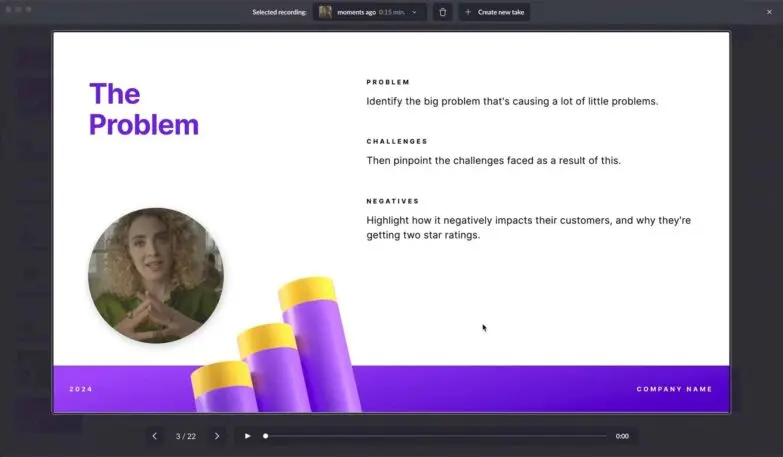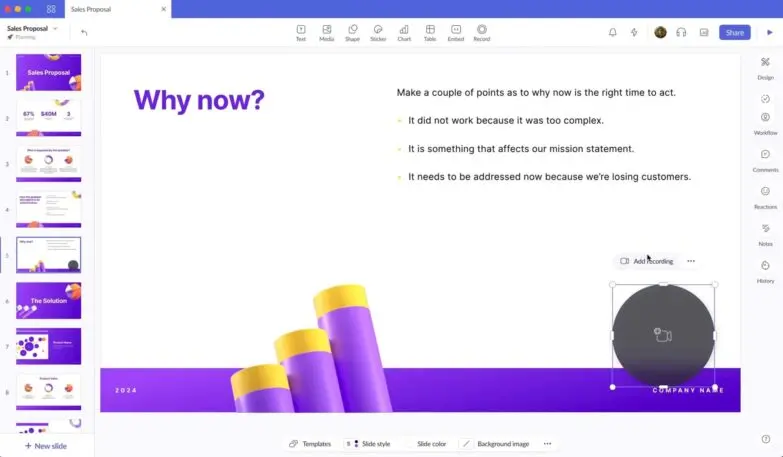Presentation apps have tried practically everything to gain an edge over Microsoft PowerPoint. They’ve given their software away for free (Google Slides, Apple Keynote). They’ve focused on simple formatting (Ludus, Paste, Beautiful.ai). They’ve positioned themselves as virtual meeting enhancers (Prezi, Mmhmm).

Alongside the new recording features, Pitch also recently launched analytics tools for tracking th e number of views for each presentation (and, in the future, seeing how much time people spent on each slide). CEO and co-founder Christian Reber hopes these kinds of features will make Pitch more useful for remote work and finally help pull people away from PowerPoint.
“The reason people are sticking to existing tools for quite a few decades now—or sticking to PowerPoint—is that no one has really entered this market in a way that was compelling to PowerPoint users,” he says.
A new kind of slide
Pitch has been around since 2018, when it launched in a private beta with a small number of businesses and promptly raised $19 million in Series A funding. Reber, who previously had co-founded the popular to-do list app Wunderlist and sold it to Microsoft, billed Pitch as “a presentation tool for the Slack generation.”
The app’s public launch came in October 2020. Amid the coronavirus pandemic, Pitch positioned itself as a collaboration tool for teams, pointing to features like the built-in video chat and the ability to pull in live data from Google Sheets. Pitch is free for individual use, and costs $8 per month for extra features such as analytics, granular access controls, unbranded PDF exports, and a built-in library for images and videos.
Today, Pitch’s scope has expanded a bit. Tomaž Štolfa, the startup’s head of presentation experience, still says Pitch is useful for teams that want to present updates asynchronously, but the company is also turning to sales and fundraising as core uses.

“Anything you can do to create a personal touch—a deck showing your face, talking through the problem, talking through the solutions—that’s a good entry point,” Štolfa says.
Pitch isn’t alone in offering recordable presentation tools. The closest equivalent is Mmhmm’s recording feature, which like Pitch allows users to record videos for each slide and to choose between multiple “takes” for each one. Prezi also offers a recording function, and you can also use screen capture software such as Descript or Loom to record video on top of other presentation apps.
Pitch’s approach is a bit different in that the actual presentations are still front-and-center. The presenter’s video can be just a small bubble on part of the screen, and it can switch to different sizes, shapes, and positions for each frame. As a result, creating a presentation with video isn’t much different than creating one with static images and text; the video is just another element to be dragged and dropped onto the screen.
“One of our real goals here was to just bring this barrier to entry into producing some really high-quality content—for whatever type of communication you might want to do with your presentation—down to the bare minimum,” Štolfa says.
Taking on PowerPoint
Pitch’s recording features alone probably won’t topple PowerPoint, but Reber says they’re just the beginning of a broader effort to create more dynamic presentations.
“If you look at the form of presentations—and we know it’s traditionally unsexy—it’s a really meaningful format to deliver information in a fast, efficient and exciting way,” he says.
Over the next couple of years, Pitch aims to build a community around its presentation creators—an idea that sounds inspired by Notion’s success with user-made templates—and add more advanced charting features. It also wants to launch plug-ins and custom embeds, allowing users to display more kinds of live data directly inside of Pitch, and it’s working on a way to turn Pitch presentations into freestanding websites.

Those types of features may end up stretching the definition of what a presentation is, but that’s the point. In the same way that apps like Notion and Coda are upending the concept of a document, Pitch believes it can disrupt the presentation without straying too far from the overall format. That might be what finally gets people to rethink their reliance on PowerPoint in the first place.
“We know that the format of presentations is actually good,” Reber says. “The process behind making and sharing them is what’s broken.”
Recognize your brand’s excellence by applying to this year’s Brands That Matter Awards before the early-rate deadline, May 3.
